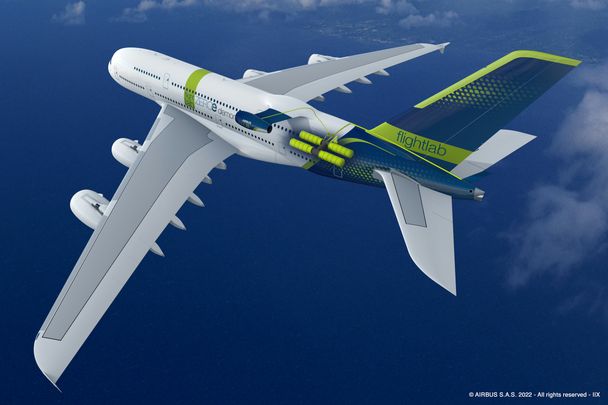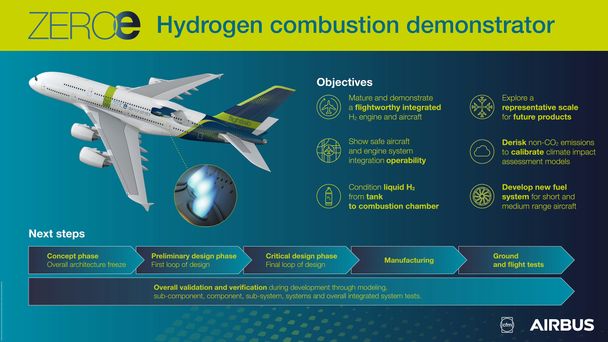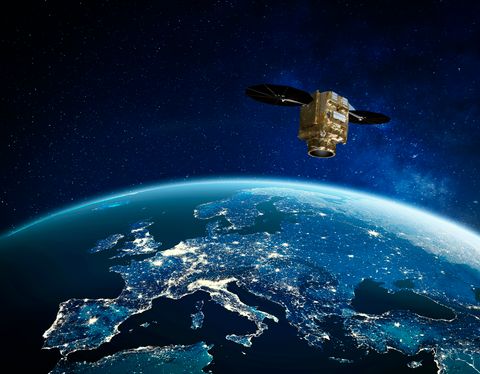At Airbus, hydrogen power gathers pace

Airbus’ aim of getting hydrogen-powered flight off the ground gets closer by the day thanks to exciting progress in the technology building blocks behind ZEROe, our low-carbon emission aircraft concept.
Forging ahead with its decarbonisation ambition, Airbus is maturing two hydrogen-based propulsion technologies in parallel. Hydrogen combustion and hydrogen fuel cells are at the heart of ZEROe, our low-carbon emission aircraft concept. H2 fuel cells are also under study as a source of non-propulsive energy. Recent months have seen plenty of achievements, so it’s time to check in for a closer look!
Hydrogen combustion (H2C)
On 12 May this year ArianeGroup, a joint venture between Airbus and Safran, successfully completed a proof-of-concept of a hydrogen ‘conditioning system’ adapted to power an aircraft turbine engine.
Given that hydrogen has to be stored at a bone-numbing -253°C, it needs to be ‘conditioned’ to reach an acceptable temperature and pressure for combustion in the aircraft engine. That’s the system’s job.
The project is known as HyPERION, and was made possible by reusing equipment designed for space applications. It’s an essential building block of the H2C technology roadmap to 2035.

At the same time, Airbus is also actively preparing a future H2C demonstrator with GE and Safran joint venture CFM International. The goal is to mature a flightworthy, fully integrated hydrogen engine and aircraft, using our own A380 test aircraft as a flying test bed.

Hydrogen fuel cells
A few months back Airbus revealed its hydrogen fuel cell engine concept which has been put through its paces at our E-Aircraft Systems test house near Munich. It’s Europe’s largest such facility. Over six months of ground testing, our expert teams have joined forces to achieve the exciting milestone of running the fuel cell at full power: 1.2 megawatts (MW).

This is the most powerful fuel cell test ever achieved in aviation anywhere in the world to date, and a great platform to learn. Airbus is alone in the aviation industry in reaching such a power ‘chain’, coupling 12 fuel cells to reach the output needed for commercial use.
What’s the significance of 1.2 Megawatts?
“In December 2020, Airbus shared with the public a 100% fuel cell powered aircraft concept. This concept was a 100-seat aircraft capable of 1,000 nautical miles and it had six engines. 1.2 megawatts is the power needed by one of these engines at take-off. So we are ground-testing a fully electric propulsion system capable of producing the take off power of a large commercial aircraft.” - Glenn Llewellyn, Airbus VP ZEROe Aircraft.
Even better, the 1.2 MW test was carried out using multiple power channels coupled together on a single propeller, helping Airbus to apply learnings to aircraft design and ultimately, manufacturing. Perhaps even more significantly, the test helps Airbus to further develop its own fuel cell knowledge, in support of certification targets for future hydrogen-powered aircraft.
ZEROe Fuel Cell engine Reveal
The test’s success is a reflection of a true team effort, involving Airbus teams across Europe and heavyweight technical partners such as Liebherr and Aerostack, Airbus’ fuel cell joint venture with ElringKlinger. Finally, it was made possible thanks to the financial support of Airbus’ home nations (LuFo in Germany, DGAC in France and CDTI in Spain) and European initiatives such as Clean Aviation and Clean Hydrogen.
Non propulsive energy
The third project is a demonstrator for non-propulsive energy (NPE), the energy which powers cabin systems and aircraft control surfaces, for example. This power - generally around 5% of the aircraft’s needs - traditionally comes from the kerosene-powered APU, or auxiliary power unit, located in the aircraft tail cone.
AIRBUS UpNext HyPower demonstrator
Airbus subsidiary UpNext’s NPE demonstrator will use a fuel cell containing ten kilograms of gaseous hydrogen generated from renewable sources to produce electrical non-propulsive power. Within three years, the cell will be tested on board an Airbus A330 in standard operating conditions. The NPE project benefits from strong support of the Spanish government and its adoption will help reduce CO2, NOx and noise emissions.
“It takes a team to turn the dream of lower-carbon flight into reality,” says Glenn Llewellyn, VP ZEROe Aircraft at Airbus. “Our hydrogen ecosystem is growing in size and in confidence. We’re on the runway and the flight path is clearer by the day. Reducing aircraft's climate impact is a massive prize at the end of the journey.”



